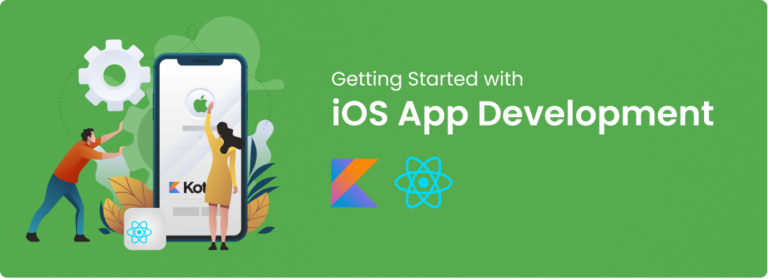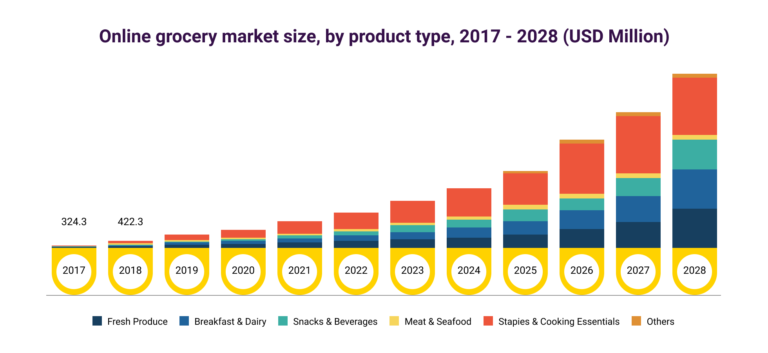Grocery Delivery App Development Cost And its Growth Potential


The online grocery market is booming, driving the demand for grocery delivery apps. To develop grocery delivery apps, consider the cost factors: features, app complexity, and developer location. Grocery delivery app development cost plays a pivotal role, with a basic app ranging from India: $10 to $50 per hour, Qatar: $30 to $90 per hour & U.S: $50 to $200 per hour.
The growth potential is substantial. In 2021, the global online grocery market hit $492.5 billion, projected to reach $1.2 trillion by 2027. Convenience, contactless delivery, and the rising demand for healthy and sustainable food options fuel this expansion.
For success, prioritize app design and user-friendliness, collaborate with reputable stores and delivery services, and employ effective marketing to reach your target audience.
To enhance business and profits, a grocery delivery app is a compelling avenue for growth. Contact Us Today!
Table Of Contents
Cost-Effective Grocery App Development
Embark on your business journey with cost-effective grocery app development. In today's competitive market, creating a robust and efficient grocery app doesn't have to break the bank. With the right development approach, you can offer your customers a seamless shopping experience while optimizing your expenses. Our expert team specializes in crafting affordable grocery apps that encompass essential features, user-friendly interfaces, and smooth functionality. From intuitive product browsing to secure payment gateways, we prioritize both quality and budget-consciousness. Join us in revolutionizing the grocery shopping landscape through cost-effective app solutions tailored to your needs. Your success is our commitment.
Is Now the Right Time to Start a Profitable Online Grocery Delivery Business?

The popularity of the online grocery sale market has risen geometrically over the past year – in fact, they are the new rave. This is partly attributed to the effects and after-effects of the novel covid, and this rise is expected to continue as more and more individuals seek secure and safe approaches to shopping, per Grandview research. Is online grocery business profitable? A relatively recent study from Grandview projected a massive surge in the online grocery market size, extending up to 2028. In 2017, the market value stood at $324 million, and according to the study, it was projected to attain over 500% of the value by 2028. Considering the projected growth and promise this space holds, exploring it is the only logical option.
Looking to get started? Read on!
How Do Online Grocery Stores Make Money For Your Business Growth?
There are diverse monetization models to help you make money from an on-demand grocery app. Here are a few:
Delivery Charges
These are one the extra charges that can improve your revenue. For some apps, the delivery cost is virtually zero, while others may charge some cash for the delivery procedures. While some individuals believe that this charge may hamper the development and growth of their business, it is quite an effective revenue-generating option.
Subscription Model
The primary benefit of adopting this model is that you can project your revenue and start budgeting your investment and techs to integrate into your app. You can find this model in an app like InstaCart which requires a meager $9.99 and an even cheaper $99.99 per annum. You may either adopt a yearly or monthly subscription basis.
Commission Fee
Another way to earn from the grocery delivery app is representing stores on the app and charging commission for every sale they make. Considering the supply and demand chain, you may also charge varying commission rates on diverse products or depending on a specific region.
Premium Advertisement
Generate extra income by allowing stores to pay an additional amount to boost their visibility on search pages and home pages. You can do this by adopting a subscription model or a one-off approach. Note that the ad placement doesn’t have to match with the theme of your app – you can make the option available for other niches as well.
Amazing Grocery Delivery App Features To Boost Your Sales
A grocery delivery app features three primary sections – user panel, delivery executive, and admin panel. Here are the features attributed to each panel:
User Panel

Simple user registration: for new users of the app, this will be their first process, setting up a profile. This will allow them to access other features such as tracking orders, making payments, and customize the app to their needs.
Simple user registration: for new users of the app, this will be their first process, setting up a profile. This will allow them to access other features such as tracking orders, making payments, and customize the app to their needs.
Product search: this is the most prominent feature of a grocery or any supermarket online delivery app. Here, after signing up or logging in, users can search for their preferred items using their preferred criteria.
Add to cart: this is another important feature that eases shopping for users who may shop from several stores. Using this feature, they can select items from various stores and place their order at once.
Favorite/search items: here is a feature that allows the user’s bookmark products or stores they are interested in. Suppose you see a product that you don’t want to purchase immediately, you can add it to favorite items and check later
Review & rating: this allows users to write their shopping experiences after using a specific store. You can manage the settings and maintain the entire review page using the user panel. It will help users know which stores to patronize and the ones to avoid.
Delivery tracking: using this feature, users can access real-time order tracking details as well as updates regarding the status of their order. This gives a real-time location as well as tracking details to facilitate the entire process
Secure payment: using the range of payment options available, users can make payments in reliable and secure means. This is the most sensitive part of the on-demand grocery app development.
Schedule delivery: in the user panel, customers can schedule delivery and make orders according to their preference and convenience. With the diverse delivery time slots available, customers can order items at any time.
Delivery Executive

Delivery boy signup: one of the most critical parts for the delivery side of your app is registration, and as such, to make the services safer and more secure, as well as track offers more effectively, every delivery person must register. This is one of the greatest grocery delivery app features.
Order notification: using this feature, the delivery person can update the customer on delivery status such as delayed, delivered, or in progress. This facilitates seamless communication between customers and the delivery side.
Accept or reject delivery requests: using the feature, the delivery side of the app can monitor and check if there are any order requests, and they can either reject or accept the orders as they deem fit.
Accessing customer location: with the GPS and Navigational features, the delivery executive can easily deliver orders to the customers using real-time location and navigation updates. They can even deliver more quickly by finding optimized routes via this feature.
In-app chat/call: the delivery executive can also contact the customers by chatting them up or via call using the dedicated messenger featured on the grocery delivery app. Just like several other features, this also facilitates communication within the app.
Admin Panel

Product management: this feature helps to tailor the items on the customer’s app to their preferences and further enhance user experience. The management options usually include; add photos, edit store info, edit product lists, etc.
Order management: order management feature allows your stores to monitor and oversee the delivery and receipt of orders. Using this customers can be updated about their orders and when they are expected to receive them.
Push notification: This feature allows the admin to send out notifications to customers. These notifications may include info such as product discounts or offers they might prefer or be interested in.
Delivery management: here, you can control and manage everything related to order delivery. Besides, this feature allows you to monitor and streamline the activities of the delivery person to further facilitate a secure platform for all.
Report and statistics: using reports and statistics, you can know the number of users who have downloaded the app and orders per day. Essentially, this helps to monitor the business and its data.
The above all are the essential grocery delivery app features.By incorporating these essential elements, your app can provide a seamless and user-friendly experience, ultimately leading to customer satisfaction and business growth.
Hours & Cost to Build a Grocery Delivery App Like Instacart, BigBasket
Are you wondering, how much does it cost to build a grocery delivery app? In this section, we will cover a rough estimate in hours for how much a grocery app development will cost you.
India: $10 to $50 per hour
Qatar: $30 to $90 per hour
U.S: $50 to $200 per hour

The app discovery phase, where you put your application ideas on paper can take roughly up to 3 hours. It is the most critical stage and a foundation that determines the longevity and sustainability of the project.
Next is the idea validation stage which could take up to 5 hours, followed by 10 hours of visuals prototyping. Going forward, you’d need to document the idea which could take up to roughly 9 hours as well.
Now, here’s where the work begins. The UI/UX design, depending on a range of factors could take up to 10-20 hours. The more technical part of the entire process is developing the app for various operating systems. Typically, iOS development would take you about 700 to 1000 hours while android development ranges from 400 to 900 hours. The backend and admin panel development could last for 300 and 60 hours respectively. Lastly, the testing, debugging, and a quality check will require about 50 hours.
All in all, developing a top grocery app like Grofers, InstaCart, or BigBasket may take up to about 700 to 1500 hours on both platform. However, we can help you streamline the entire process and achieve the best result within a relatively more negligible time frame. How?
Here, we adopt flexible yet agile processes to achieve a refined end-product within the best period and at the best rates. Our team of experts can assist your business with state-of-the-art and contemporary mobile app technologies that will actualize your ideas effectively and quickly. All you need to do is share your vision and our app development solution will help you finalize the whole process as soon as possible.


The Author
Gopinath Murugaiyan
Managing Director




